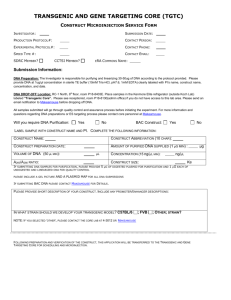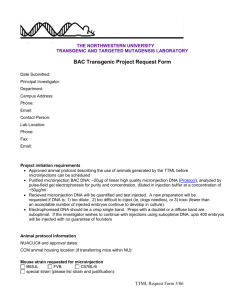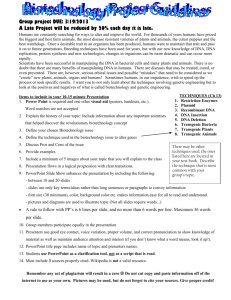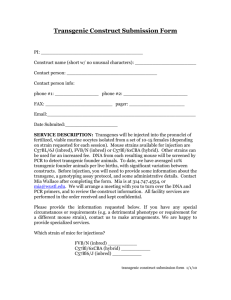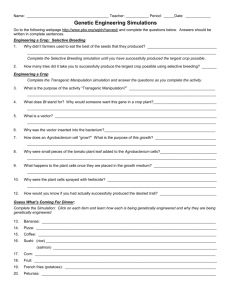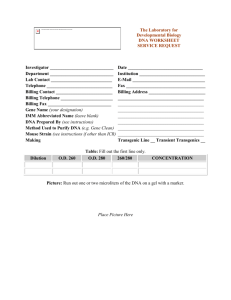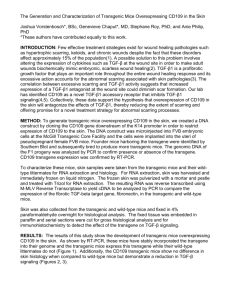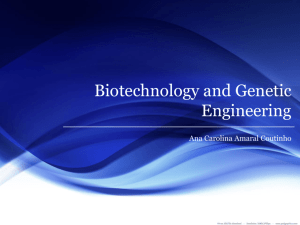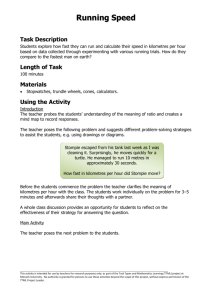Generation of transgenic lines
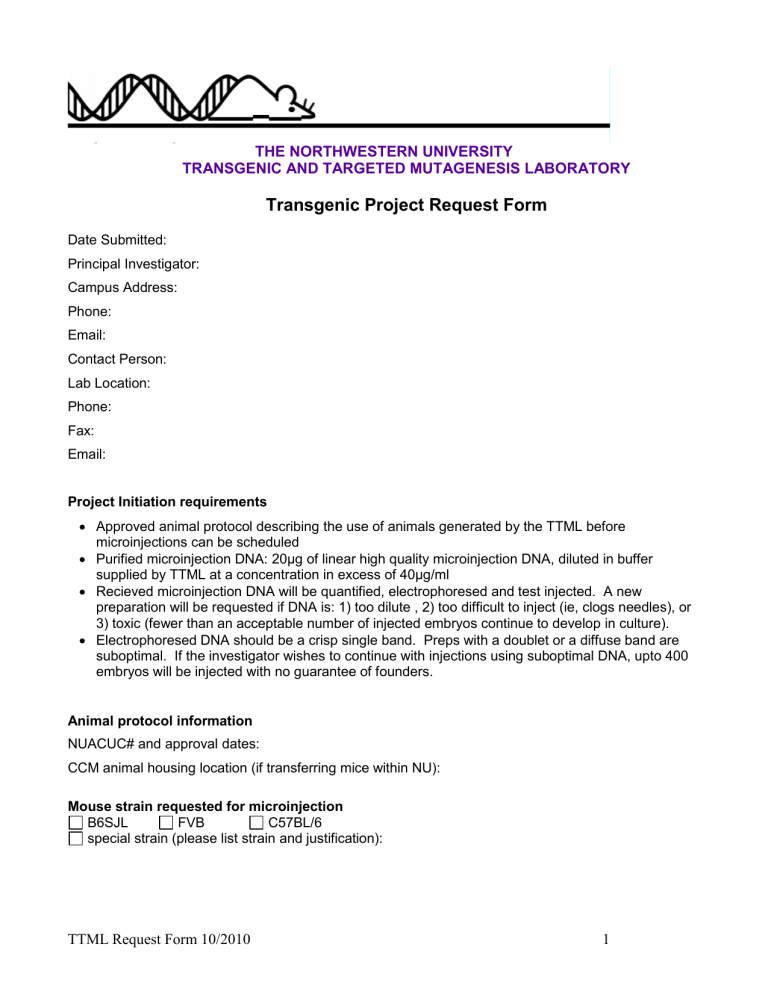
THE NORTHWESTERN UNIVERSITY
TRANSGENIC AND TARGETED MUTAGENESIS LABORATORY
Transgenic Project Request Form
Date Submitted:
Principal Investigator:
Campus Address:
Phone:
Email:
Contact Person:
Lab Location:
Phone:
Fax:
Email:
Project Initiation requirements
Approved animal protocol describing the use of animals generated by the TTML before microinjections can be scheduled
Purified microinjection DNA: 20µg of linear high quality microinjection DNA, diluted in buffer supplied by TTML at a concentration in excess of 40µg/ml
Recieved microinjection DNA will be quantified, electrophoresed and test injected. A new preparation will be requested if DNA is: 1) too dilute , 2) too difficult to inject (ie, clogs needles), or
3) toxic (fewer than an acceptable number of injected embryos continue to develop in culture).
Electrophoresed DNA should be a crisp single band. Preps with a doublet or a diffuse band are suboptimal. If the investigator wishes to continue with injections using suboptimal DNA, upto 400 embryos will be injected with no guarantee of founders.
Animal protocol information
NUACUC# and approval dates:
CCM animal housing location (if transferring mice within NU):
Mouse strain requested for microinjection
B6SJL FVB C57BL/6
special strain (please list strain and justification):
TTML Request Form 10/2010 1
Project Information
Scientific Background
Please provide a BRIEF description of the scientific rational for this project. Include a description of the relevant and/or unique features of the transgenic construct, and the expected pattern of expression and phenotype. If more than one construct is involved in this project, indicate how they differ and why each is significant to the project).
Transgene Structure
Transgene name:
Attach (or diagram below) a linear map of the transgene and label features including all regulatory elements
(promoter, enhancer, stop and start sites for transcription, stop and start sites for translation), genomic/ reporter genes, intron/exon boundaries; relevant restriction sites and probe/primer location used for transgenesis screening; and size of each sequence.
Regulatory elements: i) promoter/enhancer and source: ii) intronic sequence and source: iii) polyA source:
Is this regulatory element known to have tissue specific expression in other transgenic mice? If so, which tissues:
Have you demonstrated transgene expression in another system such as transfected cells:
Transgene Fragment Isolation and Preparation for Microinjection
One of the most critical factors affecting integration efficiency is microinjection DNA purity. If DNA is prepared using a different method than suggested by the facility, provide outline of protocol.
Enzymes used to isolate transgenic fragment from vector:
Amount of vector sequences remaining in construct:
Size of purified, injection fragment:
Concentration and volume of purified DNA:
Run 200ng of the purified transgenic fragment on an agarose gel with the appropriate size markers and visualize with ethidium bromide straining. A sharp, single band of the correct size should be evident. Attach or paste an orginal picture of the gel below.
Genotyping for Transgene Integration
Provide the following information about your screening assay and evidence that the assay is sensitive enough to detect a single copy transgene. To produce a single copy template, spike 10mg of mouse DNA with 2pg of plasmid DNA for every Kb of the control construct.
Southern Blot analysis
Enzymes(s) used to restrict genomic DNA for Southern Blot analysis:
Probe location (also indicate position on construct map):
Expected transgenic fragment size:
Expected sizes of endogenous bands (if applicable):
PCR analysis
Primer location (also indicate position on construct map):
Expected transgenic fragment size:
TTML Request Form 10/2010 2
a) Provide evidence that the transgene can be detected in genomic DNA.
Attach photograph of PCR gel or autoradiograph demonstrating sensitivity and specifcity of screening assay.
Expected Phenotype of Founder Mice
Describe any expect embryonic lethality, neonatal difficulty or death, or birth defects and provided detailed information regarding special precautions when handling pups:
Acknowledgements
Please acknowledge the Transgenic and Targeted Mutagenesis Facility in the acknowledgement section if you publish results using the mice that we help you generate. It is essential for our continued funding and success.
Suggested Text: “The genetically engineered mice were generated with the assistance of Northwestern
University Transgenic and Targeted Mutagenesis Laboratory.”
If you are a cancer center member, please also add:
“The Northwestern University Transgenic and Targeted Mutagenesis Laboratory is partially supported by NIH grant CA60553 to the Robert H. Lurie Comprehensive Cancer Center at Northwestern University.”
Please provide reprints or list of publications resulting from work completed by the facility.
TTML Request Form 10/2010 3
Billing Information
Project Name:
Principal Investigator:
Department/Division:
Lab Contact:
Lab Contact Phone:
Lab Contact Email:
PI signature: ______________________________________
Grant Title:
Grant Number:
Funding Agency:
NU Chartstring or PO#:
Full Cancer Center Member: yes
Accounting Contact (name):
Accounting Contact Phone:
Accounting Contact Email:
no
